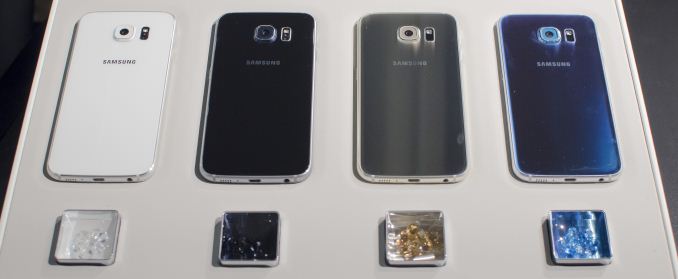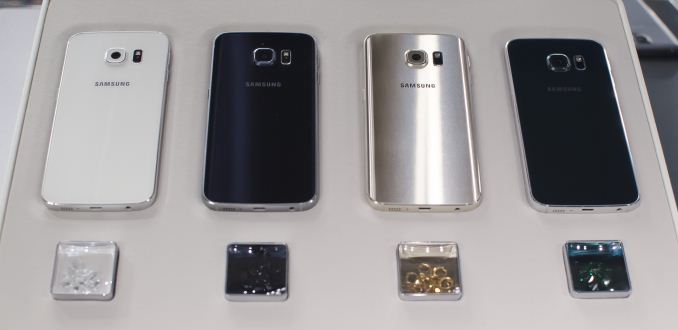Samsung Galaxy S 6 and S 6 Edge: Preview
by Joshua Ho on March 26, 2015 9:00 AM EST- Posted in
- Smartphones
- Samsung
- Mobile
- Galaxy S6
- Galaxy S6 Edge
Initial Thoughts
With the Galaxy S6 and S6 edge Samsung claimed that they wanted to completely rethink how they designed and made smartphones. On the surface, it seems that Samsung has delivered on this promise as the Galaxy S6 and S6 edge are unlikely any other Galaxy S phone they have made previously. There is no removable battery, no microSD slot, or even a removable back cover. I would’ve liked to see a microSD slot, but I personally wouldn’t be affected by being limited to 32GB of internal storage. The removable battery issue is a bit concerning for me though, as it’s likely that disassembling this phone to replace the battery will require extensive use of a heat gun to loosen glue that may not adhere properly when reassembled. The materials are now aluminum and glass, which dramatically affect in-hand feel. I definitely like the move to the aluminum and glass design for the improved look and feel of the phone, but the use of the glass back is a bit annoying as the phones have a tendency to slide off pretty much any table. The edge variant of the phone also feels quite sharp in the hand and almost too thin to hold, but this is generally quite subjective.
Outside of design, there is a lot to talk about in the SoC and display. The Exynos 7420 SoC appears to be class-leading in performance, although there is the obvious question of power consumption that still has to be answered. Samsung’s first 14LPE SoC seems promising, although we’ve yet to validate whether big.LITTLE is more efficient than when we last tested it in the Exynos 5433. The GPU is generally quite close to the Adreno 430, with about a 10-20% advantage in performance depending upon the workload, although at the same clock speed it probably wouldn’t have any advantage. The 1440p display can also reduce performance compared to a 1080p display.
Speaking of displays, Samsung has integrated an incredible display into both versions of the Galaxy S6. I’m really blown away at how far AMOLED has come in the past few years, as the Galaxy S6 is one of the best displays we’ve tested for luminance and overall color accuracy. The only real problems I can see are color shifts with viewing angles, and white point tending to be a bit green depending upon the unit we’re looking at. There are some edge-specific issues, namely uneven luminance and odd color shifting towards green hues on white at the edge of the display. Other than this, the display of the Galaxy S6 is relatively perfect with its dark, inky blacks and amazing color.
Obviously an SoC and display aren’t the only issues to discuss in a smartphone, but given the limited time that we’ve had with the device this was all that could be tested. We hope to have our full review for both devices completed in the near future, and to be able to provide the full picture of the Galaxy S6 line at that time. Pre-orders for the US Galaxy S6 variants will begin on March 27th, and the phone will go on sale on April 10th throughout the US with 32, 64, and 128 GB SKUs in Black Sapphire, White Pearl, and Gold Platinum. The S6 edge and S6 will be available on AT&T, Sprint, T-Mobile, Verizon, and US Cellular, but on Boost Mobile, Cricket Wireless, and MetroPCS only the S6 will be available.













200 Comments
View All Comments
Novacius - Thursday, March 26, 2015 - link
At the moment Qualcomm seems to have much bigger problems with S805 and S810. The S810 is throttling so much that it's GPU is just 15% faster than S801 (!) when running for a long time period.Guest8 - Thursday, March 26, 2015 - link
No Samsung 14nm is more like 20nm with fins. Same with TSM 16nm.Novacius - Thursday, March 26, 2015 - link
It's not that easy. They didn't just added FinFets and called it 14/16nm, there are other improvements, too. The density is higher for example, which wouldn't be the case if they only added fins. In my honest opinion, Samsung's 14nm process isn't too far away from Intel's.Guest8 - Monday, March 30, 2015 - link
Actually it is. It's denser because it is meant for a lower TDP. You will never see a 4 ghz version of this AP. If you do some searching you will see the characteristics for Samsung 14nm is very similar to 22nm Intel. Samsung only beat Intel to market in terms of naming convention ;-)theduckofdeath - Thursday, March 26, 2015 - link
It has the power efficiency advantages of 14nm, just not the density.FlyBri - Thursday, March 26, 2015 - link
Yea, the removal of a user replaceable battery has definitely been disappointing, but I'm going to wager a guess and say that Samsung will keep that feature in it's Note line and push users to a Note if they want/need a user replaceable battery.hrrmph - Friday, March 27, 2015 - link
That's fine for the phablet market, but this S6 marks Samsung exiting the true high-end market and bringing themselves down to the upper-middle of the market, which is where the iPhone has lived its entire life. I guess Samsung is giving up on the premium high-end phone market just like they gave up on the premium high-end mini-phone market.A lot of people still want premium high-end 5" phones and 4.5" mini-phones. So who will make flagships in those size ranges with removable batteries, Micro-SD slots, and Dual-SIMs?
The S5 DUOS may have been the last of its breed. If the manufacturers keep going cheap like they have lately and removing important features, then there may not be a premium high-end manufacturer to serve that market.
Morawka - Thursday, March 26, 2015 - link
no they wont be screwed, they'll just have to take it into a service center and pay $99 and get it replaced. Just like any other sealed phone.Morawka - Thursday, March 26, 2015 - link
regarding battery life.. yeah they added more screen and ram but you guys seem to be forgetting this uses 14nm.. leaps and bounds ahead of last years model when it comes to power consumption efficiency.ASEdouardD - Thursday, March 26, 2015 - link
GPU performance would be class leading if Samsung didn't insist on 1440p displays, which are performance eaters. That's why the iPhone 6 and the M9 beat it in GPU tests. And CPU benchmaks are pretty much always dominated by Apple (for the last few generations anyway). For an Android phone, the cpu results are great too.